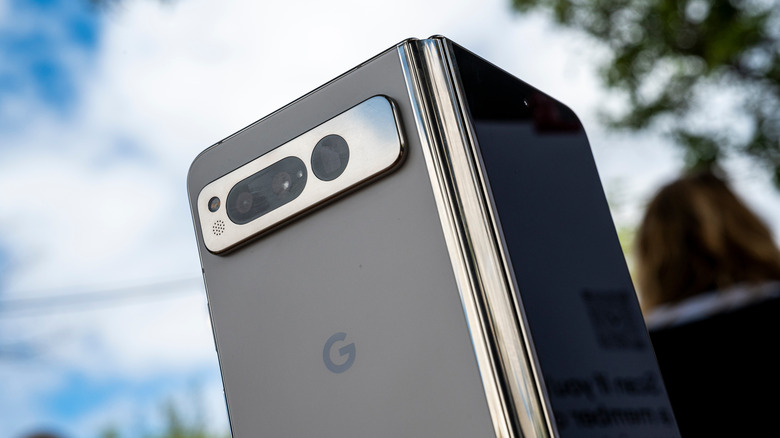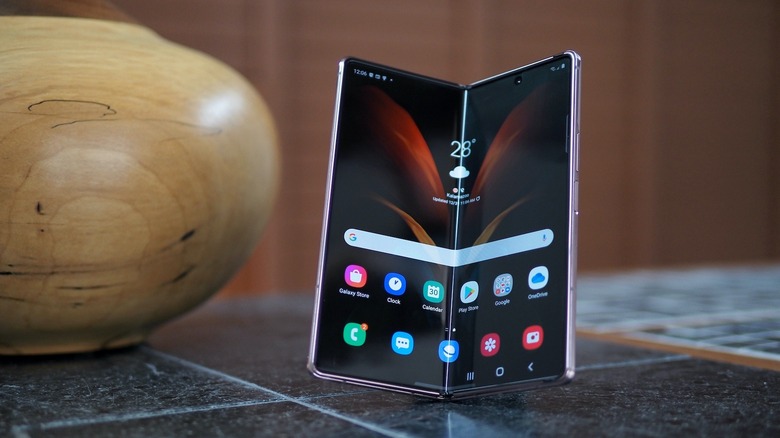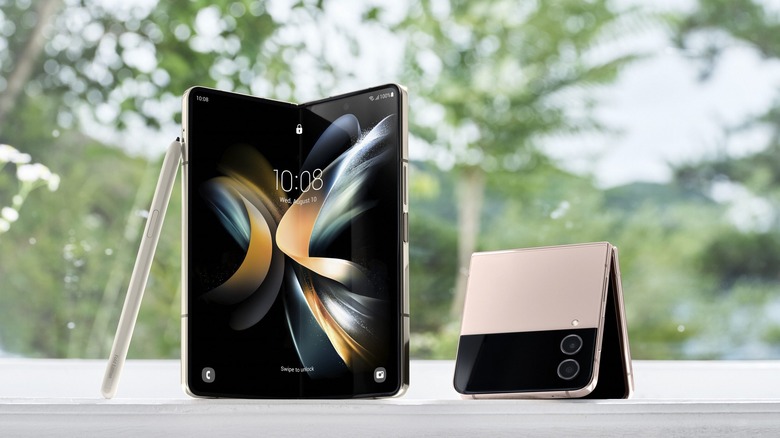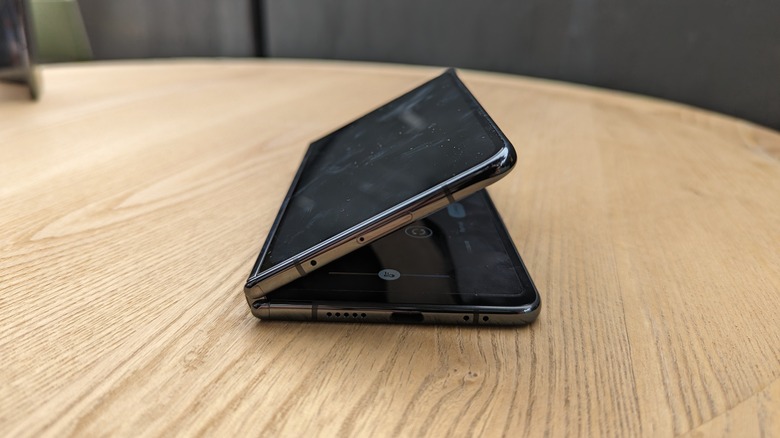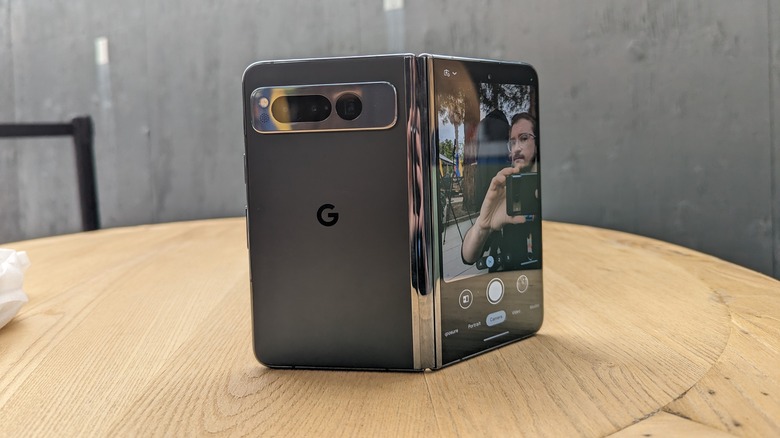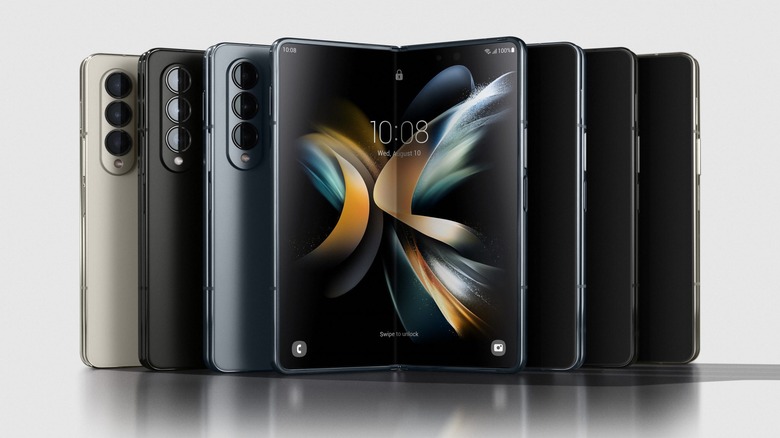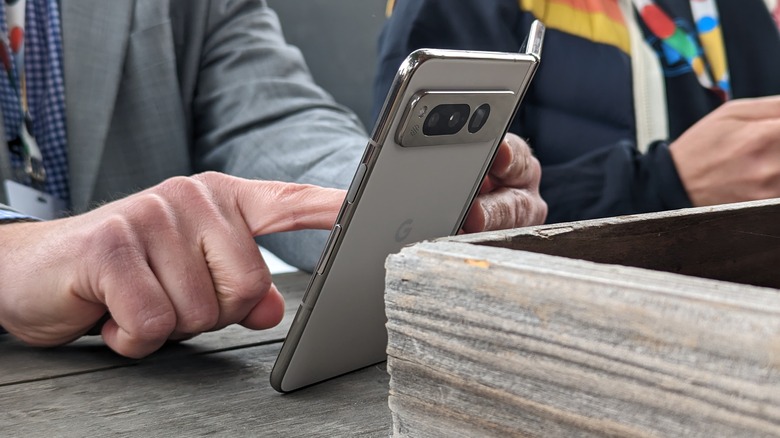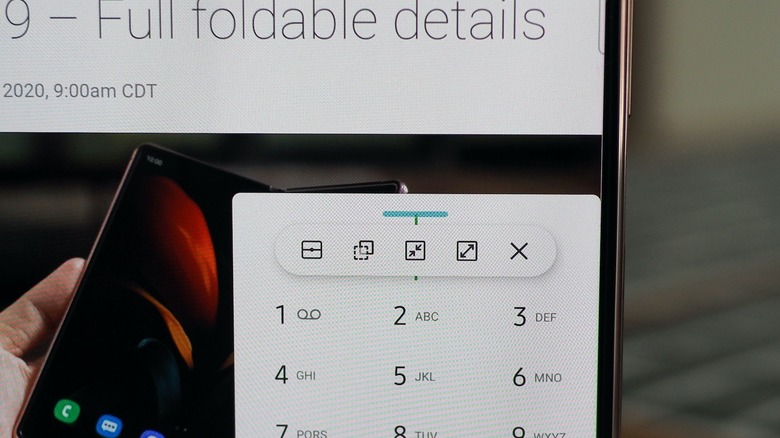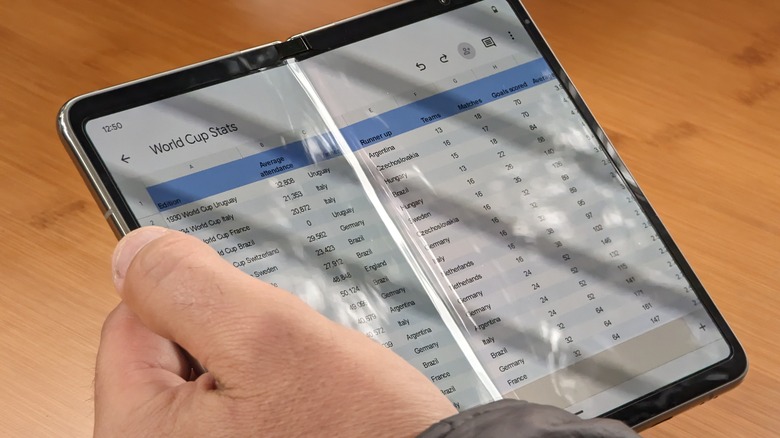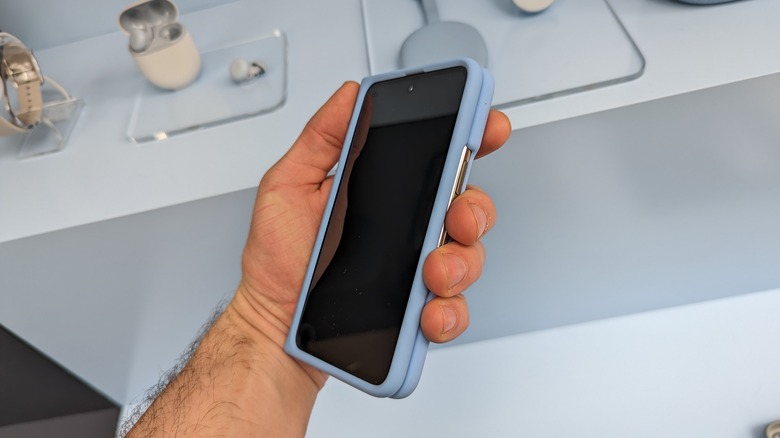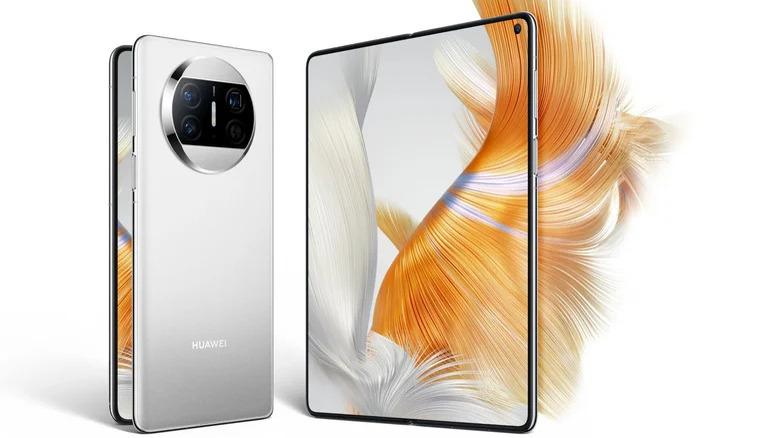10 Reasons You Shouldn't Buy A Foldable Android Phone Right Now
Up until only a few years ago, folding displays were the domain of vaporware. Touted out for tech demos at CES, they were always promised to the public as just a few years away from being a reality. Today, by contrast, it seems like everyone wants to be in the foldable game. While Samsung led the charge with its Galaxy Z line of smartphones, companies from Xiaomi to Motorola soon hopped on the trend, while companies like Lenovo worked to bring the new display technology to other product categories like laptops.
However, even in a market now filled with flips, folds, and Razrs, is foldable technology where it needs to be for mass adoption by the public? For the average smartphone buyer, is it really worth it to plunk down a stack of cash for the latest foldable phone?
Foldable devices are probably the future, but it remains difficult to recommend a foldable phone to all but the most adventurous consumers. Even then, they really only appeal to those with plenty of money to blow. Eventually, the technology will mature, but as it currently stands, issues of durability, the prevalence of midrange hardware specs, lackluster software, and a lack of real competition driving the market forward all stack up against foldable devices. Here are the reasons why you probably shouldn't buy a foldable Android phone just yet.
They're not dust resistant
Modern dust and water resistance standards have immensely reduced the amount of rice wasted by people who erroneously believed their waterlogged phone could be saved by dunking it in a bowl of jasmine. While the latest flagship foldables from Samsung and Google have a modicum of water resistance, they're not rated at all for protection from dust and debris. If you hit the beach, you'll have to leave your phone in the car, and even pocket lint can be a problem.
Water and dust resistance is measured with the ingress protection (IP) code. Written out as "IPXX," the first variable of X measures dust resistance while the second measures waterproofing. Even midrange devices like the Google Pixel 7a and Samsung Galaxy A54 come with an IP67 rating, meaning they are completely protected against dust and can be dunked in fresh water for 30 minutes at a depth of one meter. Meanwhile, the most premium foldable phones can't muster a dust resistance rating. Neither the Samsung Galaxy Z Fold 4 nor the Google Pixel Fold is rated against dust ingress. Both are certified as IPX8.
There's light on the horizon here. Motorola's new Razr+ is a flip-style foldable certified with IP52 dust and water resistance. It proves that, little by little, the inconveniences plaguing foldable phones can be fixed — but look at how much lower its water rating is. These devices are still making tradeoffs, and until that is no longer the case, it's hard to recommend a foldable Android phone.
Foldable displays are flimsy
To make a display bend nearly in half, manufacturers must craft it out of extremely bendy materials such as plastic or ultra-thin glass. In either case, that means the displays are far more prone to damage than a traditional smartphone. Samsung ships its high-end foldables with a pre-installed screen protector that it strongly warns against removing. Still, plenty of users report that their inner displays have suffered damage, particularly around the crease in the middle, which forms the axis along which the device folds shut.
For this reason, major foldable manufacturers like Samsung and Google install a plastic protective layer over the ultra-thin glass of their interior displays. At least on Samsung's phones, these can now be removed (no word yet if that's the case for the Pixel Fold), avoiding any further disasters such as the broken screen epidemic that occurred during the release of the original Z Fold, but the fact that the phones still ship with plastic protection in the first place indicates just how delicate flexible displays still are.
While progress has been made since the first generation of foldables to make them slightly more durable, there's still no comparison between the durability of ultra-thin glass and that of the much thicker glass on a traditional smartphone.
You might be out of luck if you need a repair
With an increased likelihood of damage for foldables, you'd want to at least have the peace of mind that comes with knowing you can get it fixed quickly and cheaply. However, while companies like Samsung offer semi-decent repair programs, how well those programs will work for you depends on, among other things, where you live. Your local phone repair shop can't handle the specialized repairs for foldables, and you may not live near a Samsung outlet, requiring you to mail in your damaged foldable for an extended wait period. Samsung also charges a significant amount for those repairs if you don't opt into its Care+ program, and even then, things can get pricey.
If you don't get a Samsung phone, you may well be out of luck. Tech journalists have had no shortage of bad luck trying to repair foreign market foldables. In 2019, a screen replacement for the Huawei Mate X 5G cost about $1,000 — nearly half the base price of the device itself. While foldable have become slightly more common today, they remain niche products, and that's not outside the band of what you can expect to pay for most similar device repairs.
Perhaps Google or Motorola can improve things with the releases of their latest foldables, but that's just one more reason to wait and see before picking one up.
Foldables tend to have worse cameras than their candy bar counterparts
With the massive price tag foldables command — the Galaxy Z Fold 4 and Pixel Fold both start at $1,799 — most people would expect them to come with the absolute best-in-class components. Yet, almost every foldable you can buy right now has mediocre cameras compared to cheaper phones with more traditional form factors.
The Galaxy S23 Ultra, for example, comes with a 200MP main camera. The more expensive Galaxy Z Fold 4, by comparison, makes do with a 50MP wide lens, and the new Pixel Fold sports a 48MP main lens compared to the 50MP shooter on the Pixel 7 Pro.
We described the cameras on the Z Fold 4 as "good enough," and yeah, that's about all the praise they deserve. The Pixel Fold may fare better, given Google's stellar track record with pulling magical photos from hardware that seems lackluster on paper, but it's still baffling to see such expensive devices getting worse cameras than their cheaper, non-folding siblings.
Battery life is lacking
While you might expect that a phone with a much larger screen than most would have a bigger battery to power those extra pixels, the reality is that the most popular foldable phones instead have smaller batteries than their single-screen siblings. Samsung stuck a 5,000 mAh cell into the Galaxy S23 Ultra, while the Z Fold 4 makes do with 4,400 mAh. Similarly, the Google Pixel 7 Pro gets 5,000 mAh of juice, while the newer Pixel Fold packs a slightly smaller 4,821 mAh.
While cell capacity isn't the full story when it comes to real-world battery performance, it is still the most crucial specification. Everything else comes down to processor efficiency and software optimization. Additionally, it may be the case that the bifurcated designs necessitated by the foldable form factor make it an engineering nightmare to fit big batteries inside. But in either case, these smaller batteries are one more reason to hold off on foldable phones for the time being.
Foldables don't have the latest processors
Yet again, foldables fall short on specs when it comes to processors. Since major manufacturers like Samsung and Google release their flagship foldables in the middle of the year, they end up saddled with processors that are already dated. Samsung tends to release its Galaxy Z lineup late each summer, which means last year's Z Fold 4 launched with a Snapdragon 8+ Gen 1 from Qualcomm. However, the S23 Ultra was released only six months later with the much more efficient Snapdragon 8 Gen 2.
With Google, the story is the same. The company launched its Tensor G2 chip with the Pixel 7, and that's the same chip we now have in the Pixel Fold. When the Pixel 8 launches, most likely this fall, it will almost certainly have a Tensor G3 on board.
It's not as though either foldable's processor is a slacker, but they're not the latest and greatest you'd expect from such premium devices. If you're planning to spend around $2,000 on a smartphone, you should rightfully expect it to be future-proof. Instead, you're paying for a novelty device that will show signs of aging much sooner than a regular flagship phone.
Foldable software isn't well optimized
The main reason to get a foldable, especially a tablet-style foldable, is for the multitasking potential. In theory, you should be able to edit a spreadsheet using information sent from an email without needing to switch between apps or browse the web with a YouTube video running.
The problem is the software experience on foldables remains painfully unoptimized. Unfortunately, Android simply isn't great for tablet-sized experiences, which is why even the most powerful Android tablets still feel lackluster. On foldables, which change form factor from small to large when opened, the problem is compounded. With Android 12L, Google implemented some welcome support for foldables and other large-screen experiences that Samsung took advantage of, and the upcoming Android 14 will make some much-needed compatibility improvements. Unfortunately, for all the work Google and Samsung have done, the problem is that there aren't enough large-screen Android users for most developers to bother updating their apps.
Many apps simply won't run in full screen on the larger display, while others suffer glitches when stretched to aspect ratios for which they were not designed. Some manufacturers, notably Samsung, have baked a plethora of multitasking innovations into their Android skins, but those workarounds can't solve fundamental incompatibility issues. With Google now moving into the foldable space with the Pixel Fold, things may improve, but that will happen slowly, especially given the long-standing fragmentation on Android.
You are the product tester
Despite the increasing number of foldables coming to market, they're still essentially beta products. If your screen breaks or the hinge fails, that's a massive headache for you, but it's data the manufacturer will use to improve things in the next generation. Until the foldable market has matured some more, all but the most dedicated tech enthusiasts should probably avoid them.
Many Android fans won't be happy to hear this, but the one thing that could actually force Android foldable manufacturers to step their game up and make a product worth putting in your pocket for two or more years would be a folding iPhone. Apple is an industry leader in making a new product category feel approachable to the average person. It was not the first company to make an MP3 player, nor did it invent the smartphone or tablet, but in all three instances, it was able to encourage the wide adoption of those products. Meanwhile, the reason Android phones are as good as they are today is because manufacturers had to compete against the iPhone.
However, Apple does not traditionally enter new markets until it feels like the technology exists to make the most consumer-friendly version of that product. The fact that it has held off on a foldable iPhone probably means that Tim Cook and Apple don't yet see a way to make such a product viable for the average person.
Meanwhile, Android manufacturers seem comfortable to continue iterating on the same two basic foldable form factors — flip and fold. Until one of those companies makes a massive leap forward, there's no reason to become an unpaid beta tester.
They're too expensive
All of the other shortcomings with foldables we've mentioned thus far are underscored by one simple fact we've mentioned repeatedly — foldables are wildly expensive. You can pay well over two grand for the top models from Samsung and Google, which stings a bit given that you'll be sacrificing in a lot of important areas for the privilege of a folding display. If that happens to be pocket change for you and you're a massive tech enthusiast, maybe foldables are worth a shot. Ditto if you have a legitimate daily use case for one or are a developer. Still, for most consumers, you're still better off with a traditional candy bar smartphone.
Some will say that foldables justify the high cost because they're more expensive to manufacture and require a lot of research and development. However, as a customer, it's not your job to fund Samsung's R&D division.
Moreover, foldables are priced far above their production cost. An investigation into component sourcing published by Japanese news outlet Nikkei revealed that a single Galaxy Z Fold 4 costs about $670 to make, but Samsung asks double to triple that price when it sells them to you.
As with most tech, it's probable that folding phones will get cheaper as they get better. So before you buy an underdeveloped and overpriced product now, consider waiting.
There aren't many options on the U.S. market
While other regions of the world enjoy a wide range of foldable phones from Chinese manufacturers, the United States, in an ever-escalating battle with China over economic dominance, has heavily restricted which products can be sold in the country. Walk into an electronics or carrier store in the U.S. and you won't find foldables from once-prominent companies like Huawei, Xiaomi, and Oppo.
These devices can be imported, of course, but that's a lot of work, a long wait. Further, once you get the phone in hand, you'll find its usefulness has been cut in half by a lack of Google Play Services.
That means, for all but the most hardcore tech enthusiasts in the United States, your options come down to two companies: Samsung and Google, the latter of which only introduced its first foldable this year. There's also Motorola, which has used the foldable craze to revive its hallowed Razr line of phones, but even it opted to release the Razr 2022 variant as a Chinese market exclusive, although its next model, the Razr 40, appears set for a U.S. release.
Ultimately, the foldable phone market is still in its infancy. Readers with deep memories may recall that the original iPhone was equally hamstrung, lacking many features that would later become standard on smartphones — including an app store. Buying a foldable right now is akin to getting that original iPhone in 2007. It's a decent party trick, but its revolutionary potential has yet to be realized.
